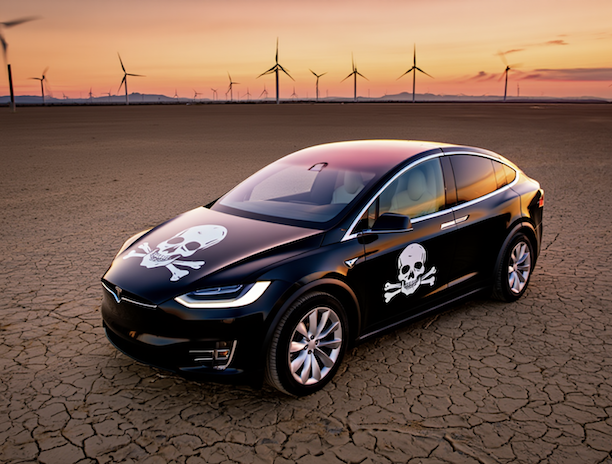| Abolition Is the Way » |
The Rare Earth and Lithium Paradox: Powering the Future, Poisoning the Planet
By Louise Hamilton
Is your new Tesla saving or destroying the Planet? We cannot electrify our way out of extraction; we can only change where the holes are dug.
The world’s “green transition” runs on a dirty paradox. The metals and minerals that underpin renewable energy—rare earth elements (REEs) and Lithium—are indispensable for wind turbines, solar panels, and electric vehicles. Yet behind the sleek marketing hubris of “zero emissions” lies an extractive reality as old as industry itself: toxic tailings, groundwater contamination, and displaced communities. In short, we are electrifying our guilt rather than erasing it.
The New Extractive Colonialist Empire: Nations and Corporations
Control of rare earths is as concentrated as oil once was. China dominates both mining and refining, producing roughly 70 percent of global supply and refining close to 90 percent of the world’s REEs (Deng & Kendall, in Schreiber et al., 2022). The United States, despite its rhetoric of “critical mineral independence,” still ships ore from its Mountain Pass mine in California to China for processing. Meanwhile, Australia’s Lynas Rare Earths and MP Materials in the U.S. struggle to challenge this monopoly, constrained by environmental costs and decades of Western outsourcing (Novikova, 2023).
In Lithium, too, the empire of extraction is expanding. Hard-rock deposits in Western Australia and brine flats in South America’s so-called Lithium Triangle—Argentina, Bolivia, and Chile—feed a global battery supply chain centered in China, South Korea, and Japan (Tedesco, 2023). The political geography is clear: the Global South digs, the Global North drives.
“Behind the mining contracts stand Western hedge funds and tech conglomerates whose green portfolios depend on outsourced degradation. Carbon neutrality, in practice, is an accounting trick — the atmosphere may cool, but the long term pollution balance sheets stay hot.”
The Elements that Make the Modern World
The lanthanides—17 elements including neodymium, praseodymium, dysprosium, and terbium—anchor the technological present. Their magnetic, phosphorescent, and catalytic properties power wind turbines, smartphones, and precision weapons (Marx et al., in Schreiber et al., 2022). Lithium, extracted from salt brines or hard rock, has become the new petroleum of the electrified age. It enables high-density energy storage in electric vehicles and renewable grids (Jiang et al., in Clemente et al., 2025).
Yet neither rare earths nor Lithium are “clean.” They are merely displaced pollutants—their emissions shifted from smokestacks to tailings ponds, their toxins buried in groundwater rather than spewed into the air.
The “How”: Green Energy’s Dirty Foundations
The renewable revolution is built upon an extractive foundation that is no cleaner than the fossil-fuel era it seeks to replace. REE ores are often intertwined with radioactive thorium and uranium; separating them requires acids and solvents that leave behind toxic, sometimes radioactive sludge. Studies confirm that rare earth mining carries higher life-cycle environmental impacts—especially in acidification potential and radionuclide release—than many conventional metals (Schreiber et al., 2022). In China’s Baotou region, vast unlined tailings ponds have transformed farmland into wasteland, a radioactive scar in the name of progress (ScienceNews, 2023).
The same pattern repeats in Lithium extraction. From Chile’s Atacama Desert to Tibet’s high plains, brine extraction depletes scarce water tables, threatening Indigenous agriculture and fragile ecosystems (Tedesco, 2023). The industry’s defenders call it a “strategic necessity.” Environmental scientists call it a slow-motion hydrological collapse.
“In Chile’s Atacama Desert, 63-year-old farmer Lorenzo Poma says the wells his family once drew from ‘turn to dust by noon.’ The Lithium ponds shimmer blue under the sun, but he calls them ‘the dead lakes.’ For him, each new EV battery abroad means another dry season at home.”
The Battery Delusion: Waste Without a Future
Even after the mining stops, the pollution continues. Despite their ubiquity, Lithium-ion batteries (LIBs) have no economically viable large-scale recycling system. Complex chemistries and safety risks make recovery difficult and costly. As of 2025, less than five percent of spent LIBs are recycled globally (Tarpeh et al., 2024).
The remainder—billions of cells filled with Lithium, cobalt, nickel, and flammable electrolytes—enter the waste stream. In landfills, they corrode and rupture, releasing toxic metals and organic solvents. Research indicates that domestic LIBs often exceed hazardous-waste leachate limits under U.S. regulatory tests (Xu et al., 2023). As they degrade, the resulting leachate seeps into groundwater, threatening aquifers that supply drinking water and irrigation systems (Zeng et al., 2021).
The industry rarely mentions this. Policymakers tout electric mobility as “zero-emission,” while the real emissions dissolve unseen—molecular, migratory, and irreversible.
Lithium in the Water Cycle: The Next Slow Poison
Lithium is neither inert nor benign. It is a biologically active alkali metal that readily dissolves and persists in aquatic systems. Long used in psychiatry as a mood stabilizer, Lithium is effective precisely because it alters neurochemistry. Chronic low-level exposure through water or food systems, therefore, cannot be dismissed as harmless. Researchers note that even modest Lithium concentrations can affect plant growth, soil microbes, and aquatic organisms (Albarano et al., 2022).
As global production of electric and hybrid vehicles accelerates, so too will the leaching of Lithium from retired batteries into the environment. Once in groundwater or irrigation canals, Lithium bioaccumulates in crops, reducing yields and entering the food chain. A review warns that spent LIBs “will release pollutants into the water, air, and soil” unless carefully managed (Xu et al., 2023). In the long term, elevated Lithium levels in drinking water could become a public-health issue hiding in plain sight—an environmental analog to microplastics, invisible but pervasive.
Seldom-Discussed Realities
1. The Intergenerational Debt of Tailings and Battery Waste
Mining tailings from rare earths and Lithium are not temporary nuisances; they are multi-centennial liabilities. Radioactive and chemically aggressive residues require indefinite containment. In poorer regions, tailings ponds are often unlined, unmonitored, and left to erode. The hidden cost of every wind turbine and electric car may well be measured in poisoned aquifers a generation from now.
2. The Mirage of “Circular Economy”
The rhetoric of circularity suggests that battery metals will be endlessly recycled. In practice, the economics do not work. Even under optimistic scenarios, recovered Lithium costs more than newly mined Lithium (Tarpeh et al., 2024). Until the economics invert—or regulation intervenes—the world’s electric vehicles will leave behind a trail of buried Lithium, silently seeding the hydrosphere.
Toward an Honest Green Transition
None of this invalidates the need for decarbonization. But honesty is the prerequisite for sustainability. The “green transition” is not clean until it accounts for the full ecological ledger—from mine to landfill, from brine pool to bloodstream.
Solutions exist but require political will:
- Mandatory recycling targets for Lithium-ion batteries, subsidized to overcome cost barriers.
- Cleaner extraction technologies for REEs, including solvent-free separation and closed-loop water systems.
- Global monitoring of Lithium and rare-earth contamination in soils and aquifers, particularly in agricultural zones.
As environmental chemist Federico Tedesco (2023) observed, “We cannot electrify our way out of extraction; we can only change where the holes are dug.” Until then, the rare earth and Lithium industries will remain the paradox at the heart of the green dream—powering the future while quietly poisoning it.
“If this century’s salvation depends on the same logic that destroyed the last, then green is only the new gray. Each purchase decision remains an act of quiet consent in this ongoing extraction. A truly renewable future begins not with the next battery breakthrough, but with a reckoning — that sustainability without justice is just another form of colonialist extraction, gilded in faux feel good virtue.”
Sources
Albarano, L., et al. (2022). Ecotoxicology of Rare Earth Elements and Lithium. Frontiers in Environmental Science. https://doi.org/10.3389/fenvs.2022.948041
Deng, J., & Kendall, A. (in Schreiber et al., 2022). Environmental Life Cycle Assessment of Rare Earth Elements. Environmental Science & Technology. https://pmc.ncbi.nlm.nih.gov/articles/PMC8929459
Jiang, Y., et al. (in Clemente et al., 2025). Lithium-Ion Battery Supply Chains and Environmental Impacts. arXiv Preprint. https://arxiv.org/abs/2506.05531
Novikova, E. (2023). Rare Earth Mining: Sacrificing the Environment to Save the Planet. Foreign Policy in Focus. https://fpif.org/rare-earth-mining-sacrificing-the-environment-to-save-the-planet
Schreiber, A., et al. (2022). Life-Cycle Assessment of Rare Earth Elements: Environmental Impacts and Sustainability. Environmental Science & Technology, 56(9). https://pubmed.ncbi.nlm.nih.gov/35316936
ScienceNews. (2023). Rare-Earth Mining’s Environmental Toll. https://www.sciencenews.org/article/rare-earth-mining-renewable-energy-future
Tarpeh, S., et al. (2024). Recycling Lithium-Ion Batteries Cuts Emissions and Strengthens the Supply Chain. Stanford News. https://news.stanford.edu/stories/2025/01/recycling-Lithium-ion-batteries
Tedesco, F. (2023). The Paradox of Lithium. Columbia Climate School. https://news.climate.columbia.edu/2023/01/18/the-paradox-of-Lithium
Xu, Z., et al. (2023). Lithium Battery Waste and Environmental Risk: Review and Perspective. Membranes, 14(12), 277. https://www.mdpi.com/2077-0375/14/12/277
Zeng, X., et al. (2021). End-of-Life Management of Lithium-Ion Batteries: Environmental and Resource Perspectives. Energy & Environmental Science, 14, 4031–4053. https://pubs.rsc.org/en/content/articlelanding/2021/ee/d1ee00691f
The Rare Earth and Lithium Paradox: Powering the Future, Poisoning the Planet
By Louise Hamilton



